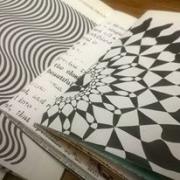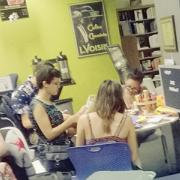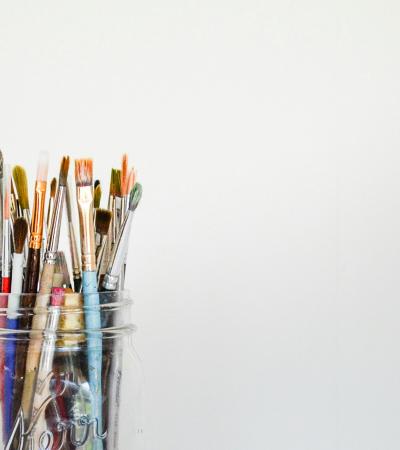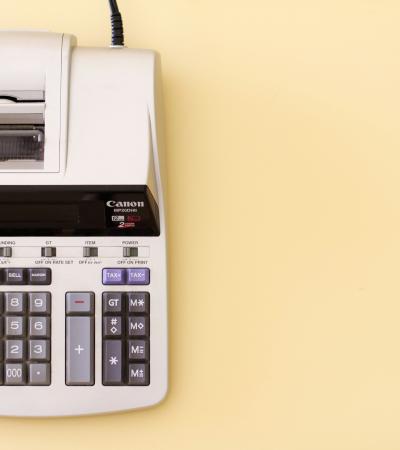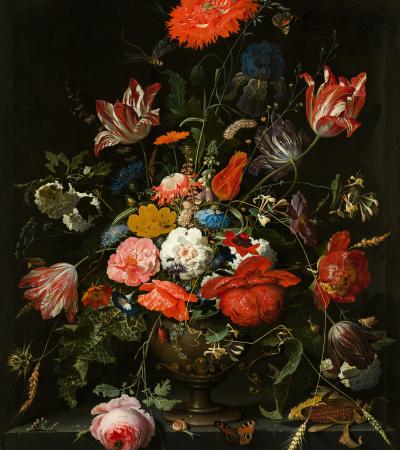Library Zine Night is a monthly opportunity for participants to work alone or collaboratively on zines, comics, artist books or other paper projects in the library for a few hours. The library provides staplers, trimmers, bookbinding materials, basic drawing supplies, paper, adhesives, scissors, discarded book scraps, scanners and free photocopying. Occasionally, we invite zinesters in the community to come in for demonstrations on new techniques and approaches.
Each month is usually themed by subject matter (e.g. politics, activism, music, pop culture, indie comics) or by technique (e.g. collage, cross-outs, illustration) or format (e.g. single pagers, saddle stapled). The library also provides button-makers, sticker paper, vinyl cutters and other materials useful for zine promotion.
Library Zine Night is sponsored by the Aesthetics of Research, an ongoing project that works through the library's access services department and is devoted to exploring the intersection of libraries and the arts.
Advanced Planning
In spring 2015, the library's Aesthetics of Research project began an informal zine exchange on the first floor, which had a rack featuring both original zines left by community members and zines they were wanting to trade. The following spring, in an effort to garner interest and enthusiasm for the exchange, we decided to host our first Zine Night. This event lasts a few hours every month, allowing zinesters, book artists, etc., an opportunity to come together to work on projects.
Most of the preparation involves working out supplies, many of which we already have access to. (See a list of suggested zine supplies under "Attachments" at right.) However, we did invest in some fancier papercrafting scissors, punches and a perforator. We also pulled together a number of sample zines to provide inspiration and direction.
Our goals and outcomes were to:
- Garner enthusiasm and participation for the zine exchange rack and increase awareness of zine-making in general.
- Allow participants a chance to use our equipment and materials to work on their projects.
- Give participants an opportunity to collaborate and connect with other zinesters and book artists, as well as share and promote their work.
- Occasionally bring in guest zinesters to demonstrate new techniques and approaches.
We initially set up the zine-making station in a fourth floor lounge area, but have recently moved it down to our first floor lobby/circulation area, which has garnered a bit more traffic and participation. It has also allowed staff a little more flexibility in overseeing it, as well as easier access to the photocopiers. Additionally, we found it helpful to have a small craft cart dedicated to supplies, which can be wheeled to the desired location. (We have also taken zine-making to a couple external locations, including a lit festival and an academic conference.)
Marketing
We began by promoting through the usual channels, including posters, electronic displays and images on the website, as well as promotion via both the library's and Aesthetics of Research's social media (Facebook, Twitter, etc.). (See a poster under "Attachments" at right.) We also formed connections to other colleges and communities doing similar work, including the Chicago Zine Fest, Chicago Alternative Comics Expo (CAKE) and Chicago Publisher's Resource Center (some of whose members have participated in our programming, including the library's annual Little Indie Press Festival).
This year, the first couple Zine Nights of the semester were also tied in with our new student orientation program, Engage Columbia, which brought in a number of new students to participate and learn about zine-making. We are also currently looking into collaborations with faculty on campus to integrate zine-making into their classes and how the library can play a role in facilitating that.
Budgeting
While we have spent a bit of funds to round out our collection of supplies, the event at its simplest can definitely occur for little to no expense. I suggest you take advantage of the equipment that the library already has (e.g. staplers, trimmers, exactos, scissors, photocopiers). You may already have a variety of sized papers on hand, including standard-size copier paper and larger 11-by-17 sheets.
Discarded materials are excellent elements to cut up and use for collage or zine pages. With a little bit of funds, you can invest in more paper options, a zine cart, display rack and more materials or equipment. Our MakerLab recently obtained several button-makers, which we also occasionally bring out for Zine Nights.
Day-of-event Activity
Set-up for Zine Nights is fairly efficient and quick, requiring only one or two staff members. Depending on location and/or duration, it's advisable to have one staffer on hand to assist, answer questions and oversee materials. You can plan it as a more formal workshop if you have a demonstration planned, or a free-form station from which people can come and go as they please. It is also helpful, especially in the latter format, to have sample zines on hand if participants don't know where to start. (See a list of zine technique samples under "Attachments" at right.)
Program Execution
In the two semesters Zine Nights have been occurring every month, we have had anywhere from 2 to 15 attendees. Our tie in with Engage Columbia netted the largest attendance boost in fall 2016.
While attendance can vary, we have gotten excellent feedback from participants, who have enjoyed the opportunity to expand their skills and socialize with other zinesters. We hope to further gain momentum as subsequent semesters progress and we continue to promote the events and form curricular connections with faculty. Our zine exchange, in turn, definitely has gotten more diverse and numerous in its offerings.
Advice
Depending on your budget and staffing resources, it is completely OK to start small, even if that means a couple of staplers, some copy paper and some zine folding technique know-how. With a little research or some excellent demonstrations, a lot can be accomplished on a simple and inexpensive level. In fact, that is how most indie press and zine-making endeavors start.
If you are holding programs monthly it may be easy to get discouraged at small initial attendance numbers, but keep the faith. Word spreads and communities gain momentum over time and within a year, your Zine Nights may be a success.

